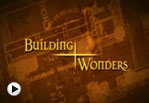Brief History of Bristol as a Port
Until the early 19th century, rivers were the most important means of moving goods and people around the country. Bristol grew up around the point where the rivers Avon and Frome met, a convenient crossing place at the furthest point inland that ships could reach by drifting on the tidal current. The earliest evidence of Bristol as a named place (Bristol means ‘Bridge place’) is about the year 1000, but the Romans had a port further down the river Avon at Abonae (now Sea Mills).
The effectiveness of the port was much improved in 1240s by major civil engineering work to divert the river Frome and create a wide and deep artificial channel. This in turn enabled the building of the Quay, now Broad Quay, which was to become the harbour’s principal wharf right through to the 19th century.
In the 1300s, Bristol was the second most important port in the country after London. Woollen cloth woven in the Cotswolds was brought to Bristol for finishing and dyeing before export to Gascony in south west France (around Bordeaux). Red cloth was prized particularly, and Bristol had a monopoly of this. Ships returned with wine from the region.
At the end of the 1400s, this trade declined and Bristol merchants had to look elsewhere for cargoes. Bristol merchants built trading links with Spain and Portugal, the Baltic states, North Africa and the Mediterranean, but couldn’t break into the very valuable spice trade with the East. This began a period of exploration in search of a route to the Far East by sailing westward (around the world in the opposite direction). This culminated in John Cabot’s voyage in 1497, when he is thought to have discovered Newfoundland and the mainland of America.
At the end of the 1600s, Bristol merchants broke into the lucrative Africa trade, transporting trade goods, including cooking pots and guns, to West Africa, exchanging these for enslaved African people and carrying them to the West Indies and America. There they were sold to buy sugar, tobacco and other luxury goods grown on plantations. For a time, Bristol was the main port in this trade but by the 1750s most merchants traded directly with the Caribbean rather than transporting African people; there were fewer risks involved in this. At this time, too, Bristol regained its place as second port in the kingdom, but was quickly overtaken by Liverpool and other new ports before the end of the century.
After the creation of the Floating Harbour, Bristol continued to grow as a port, but declined in overall importance – other places expanded more quickly because they benefited from the development of industry in the north of England. In the 1830s, Isambard Kingdom Brunel built two ships in the port, the paddle steamer Great Western and later the iron screw steamship Great Britain. Each was the largest ship in the world when it was built. After this shipbuilding declined, although some ships are still built in Bristol today.
In the 1870s, new docks were built on the Severn estuary at Avonmouth and Portishead to accommodate larger ocean-going ships. Avonmouth was expanded greatly throughout the 1900s and became the main centre of the Port of Bristol, although the Floating Harbour (known as the City Docks) remained important until its closure to commercial traffic in 1975. In 1977, another enormous new dock was opened at Royal Portbury (on the south side of the mouth of the Avon) and it, with Avonmouth, is the thriving centre of Bristol’s present day port.






